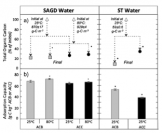This study explored the feasibility of using residual biomass to both mitigate greenhouse gas (GHG) emissions and remediate water contaminated by hydrocarbons. Using produced (process-affected) water from Canada’s oil sands operations as a case study, activated biochar (ACB) was found to have a higher affinity to organics than activated coal and removed 75 % of total organic carbon (TOC) from produced water in steam-assisted gravity drainage (SAGD) operations or 90 % of the TOC from synthetic tailings (ST) water sample. Up to 6 Tg dry biomass year−1 would be required to treat the waters associated with the 93× 106-m3 of bitumen recovered per year. Landfilling the spent ACB and flaring any biogas produced were estimated to provide a greater GHG benefit than the combustion of the biochar + organics for heat to offset natural gas demand. Net costs for the ACB were about 13.84$m−3 bitumen for SAGD operations and 1.76$m−3 bitumen for mining operations. The values for mining operations justify further work to create a value chain that will integrate bioprocesses into the fossil fuel industry.

